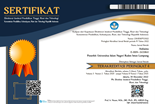Pengaruh Keterlibatan Ayah (Father Involvement) Terhadap Empati Pada Remaja Yang Memiliki Saudara Kandung Autisme (Siblings With Autism)
Abstract
Empathy is the ability to understand the emotional state of others which makes it easier for teenagers to understand and accept the situation of their autistic siblings, improve relationships and minimize conflict. This study aims to determine the role of father involvement on empathy in adolescents who have autistic siblings. A total of 88 adolescents who have siblings with autism were taken using the snowball sampling technique. There were two scales, father involvement scale (35 items) and Basic Empathy Scale (20 items. By using simple regression analysis techniques, the results showed R2 = 0.564 with a value of T = 10.538 with p = 0.000 (p <0.01), means there is a significant positive correlation between father involvement and empathy in adolescents who have siblings with autism. This research underlines the importance of father involvement to develop empathy for sibling interaction, particularly they who have autism sibling.
Keywords: Father's Involvement, Empathy, Sibling with autism.
Keywords
Full Text:
PDFReferences
Adamsons, K., & Johnson, S. K. (2013). An updated and expanded meta-analysis of nonresident fathering and child well-being. Journal of Family Psychology. 27(4), 589.
Ambarini, T. K. (2006). Saudara Sekandung dari Anak Autis dan Peran Mereka dalam Terapi. Fakultas Psikologi Universitas Airlangga, 8(2).
Andayani, B. K. (2004). Peran Ayah Menuju Coparenting. Sepanjang: CV. Citra Media.
American Psychological Association. (2013). Diagnostic and Statistical Manual of Mental Disorders (Fifth ed.). Washington DC: American Psychiatric Publishing. Retrieved from https://dsm.psychiatryonline.org/doi/abs/10.1176/appi.books.9780890420249.dsm-iv-tr
Argys, L. M., Rees, D. I., Averett, S. L., & Witoonchart, B. (2006). Birth order and risky adolescent behavior. Economic Inquiry, 215-233.
Astria, N., & Setyawan, I. (2020). Studi Fenomenologi Resiliensi Ibu Yang Memiliki Anak Dengan Autisme. Empati, 9(1), 27-46.
Azwandi, Y. (2005). Mengenal dan membantu penyandang autisme. Jakarta: Departemen Pendidikan Nasional.
Benderix, Y. &. (2007). Siblings' experiences of having a brother or sister with autism and mental retardation: a case study of 14 siblings from five families. Journal of pediatric nursing, 22(5), 410-418.
Bernadett-Shapiro, S., Ehrensaft, D., & Shapiro, J. L. (1996). Father participation in childcare and the development of empathy in sons: An empirical study. Family Therapy: The Journal of the California Graduate School of Family Psychology, 23(2).
Blankenship, J. (2015). Autism as an ambiguous loss: The experience of multiple family members. Clinical Dissertation, Alliant International University. Retrieved from https://search.proquest.com/openview/ddb6c976267bbdd546ed378e9e61b88f/1?pq-origsite=gscholar&cbl=18750&diss=y
Borba, M. (2008). Membangun Kecerdasan Moral: Tujuh Kebajikan Utama Agar Anak Bermoral Tinggi. Jakarta: PT Gramedia Pustaka Utama.
Calandri, E., Graziano, F., Testa, S., Cattelino, E., & Begotti, T. (2019). Empathy and depression among early adolescents: the moderating role of parental support. Frontiers in psychology, 10.
Canha, M. (2010). Siblings of Children with Autism: An Exploratory Study of Sibling Concerns and Coping Strategies. Undergraduate Review, 42-46.
Dabrowska, A., & Pisula, E. (2010). Parenting stress and coping styles in mothers and fathers of pre-school children with autism and Down syndrome. Journal of Intellectual Disability Research, 54(3), 266-280.
Dadds, M. R., Hunter, K., Hawes, D. J., Frost, A. D., Vassallo, S., Bunn, P., & El Masry, Y. (2008). A measure of cognitive and affective empathy in children using parent ratings. Child psychiatry and human development. 111-122.
Davis, N. O., & Carter, A. S. (2008). Parenting stress in mothers and fathers of toddlers with autism spectrum disorders: Associations with child characteristics. Journal of autism and developmental disorders, 38(7), 1278.
Decety, J., & Moriguchi, Y. (2007). The empathic brain and its dysfunction in psychiatric populations: Implications for intervention across different clinical conditions. BioPsychoSocial medicine, 1(1), 22.
El Nokali, N. E., Bachman, H. J., & Votruba‐Drzal, E. (2010). Parent involvement and children’s academic and social development in elementary school. Child development, 81(3), 988-1005.
Feshbach, N. D., Caprara, G. V., Lo Coco, A., Pastorelli, C., Manna, G., & Menzres, J. (1991). Empathy and its correlates: Cross cultural data from Italy. In Eleventh biennal meeting of the International Society for the Study of Behavioral Development, Minneapolis.
Hawkins, A. J., Bradford, K. P., Palkovitz, R., Christiansen, S. L., Day, R. D., & Call, V. R. (2002). The inventory of father involvement: A pilot study of a new measure of father involvement. The journal of men’s studies, 10(2), 183-196
Hoskinson, J. E. (2011). How does having a sibling with autism spectrum conditions impact on adolescents' psychosocial adjustment?. Doctor of Clinical Psychology, University of Leeds. Retrieved from http://etheses.whiterose.ac.uk/2029/1/Thesispdf.pdf
Jolliffe, D., & Farrington, D. P. (2006). Development and validation of the Basic Empathy Scale. Journal of adolescence, 29(4), 589-611.
Kandel, I., & Merrick, J. (2007). The child with a disability: parental acceptance, management and coping. The scientific world Journal, 7, 1799-1809.
Kementerian Pendidikan dan Kebudayaan. (2017). Statistik Persekolahan PLB 2017/2018. Jakarta: Pusat Data dan Statistik Pendidikan dan Kebudayaan.
Kestenbaum, R., Farber, E. A., & Sroufe, L. A. (1989). Individual differences in empathy among preschoolers: Relation to attachment history. New Directions for Child Development, 44, 51–64.
Koestner, R., Franz, C., & Weinberger, J. (1990). The family origins of empathic concern: A 26-year longitudinal study. Journal of Personality and Social Psychology. 709.
Krevans, J., & Gibbs, J. C. (1996). Parents' use of inductive discipline: Relations to children's empathy and prosocial behavior. Child development, 3263-3277.
Kristiana, I. F. (2016). Perukah Membedakan? Pengalaman Pengasuhan Dalam Keluarga Yang Memiliki Anak Autism Spectrum Disorder (Asd) Dan Tipikal. Jurnal Psikologi Undip, 15(2), 108-116.
Lamb, M. E., Pleck, J. H., Charnov, E. L., & Levine, J. A. (1985). Paternal behavior in humans. American zoologist, 883-894.
Lamb, M. E. (2010). How do fathers influence children’s development? Let me count the ways. The role of the father in child development, 1-26.
Lang, S. N., Schoppe-Sullivan, S. J., Kotila, L. E., Feng, X., Kamp Dush, C. M., & Johnson, S. C. (2014). Relations between fathers’ and mothers’ infant engagement patterns in dual-earner families and toddler competence. Journal of Family Issues, 35(8), 1107-1127.
Mangunsong, F. (2011). Psikologi dan Pendidikan Anak Berkebutuhan Khusus Jilid Kedua. Depok: LPSP3 UI.
Michel, J. (2019). Living with autism: The experience of developmentally healthy adolescents and youths who have a sibling diagnosed with autism spectrum disorder. Clinical Psychology, Edith Cowan University. Retrieved from https://ro.ecu.edu.au/cgi/viewcontent.cgi?article=3176&context=theses
Miklikowska, M., Duriez, B., & Soenens, B. (2011). Family roots of empathy-related characteristics: The role of perceived maternal and paternal need support in adolescence. Developmental Psychology. 1342.
Orsmond, G. I. (2007). Siblings of individuals with autism spectrum disorders across the life course. Mental retardation and developmental disabilities research reviews, 313-32.
Petalas, M. A., Hastings, R. P., Nash, S., Reilly, D., & Dowey, A. (2012). The perceptions and experiences of adolescent siblings who have a brother with autism spectrum disorder. Journal of Intellectual and Developmental Disability, 37(4), 303-314.
Ramchandani, P., Stein, A., Evans, J., O'Connor, T. G., & ALSPAC Study Team. (2005). Paternal depression in the postnatal period and child development: a prospective population study. The Lancet, 365(9478), 2201-2205.
Shivers, C. M. (2019). Empathy and perceptions of their brother or sister among adolescent siblings of individuals with and without autism spectrum disorder. Research in developmental disabilities, 92, 103451.
Simatupang, R. M. (2015). Pola relasi saudara pada remaja yang memiliki saudara dengan gangguan spektrum autisme. Jurnal Psikologi Klinis dan Kesehatan Mental, 4(01).
Tias, A. R. (2014). Hubungan persaudaraan pada remaja yang saudara kandungnya penyandang autisme. Doctoral dissertation, Universitas Islam Negeri Sultan Sarif Kasim Riau. Retrieved from http://repository.uin-suska.ac.id/5885/3/BAB%20II.pdf
Ward, B. (2016). Sibling Experiences: Living with Young Persons with Autism Spectrum Disorders. Pediatric nursing, 42(2).
DOI: http://dx.doi.org/10.24042/ajp.v5i1.13188
Refbacks
- There are currently no refbacks.
Copyright (c) 2022 ANFUSINA: Journal of Psychology











